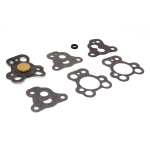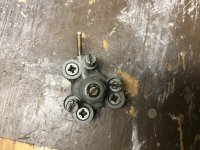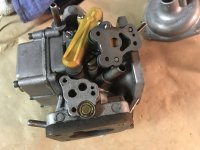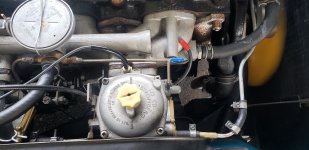-
 Hi Guest!
Hi Guest!
If you appreciate British Car Forum and our 25 years of supporting British car enthusiasts with technical and anicdotal information, collected from our thousands of great members, please support us with a low-cost subscription. You can become a supporting member for less than the dues of most car clubs.
There are some perks with a member upgrade!**Upgrade Now**
(PS: Subscribers don't see this gawd-aweful banner

Tips
- We have a special forum called "Member Articles" where you can submit actual articles for consideration for publication. Learn More
- Don't have an Avatar? If not, your avatar will default to the 1st character in your username. Go into "Account Details" to change your Avatar.
- Some basic forum navigation info: click
Hey - did you know if you click on the title of a thread it will take you to the first unread post since you last visited that thread?
- Hey Guest - Is your British Car Club in our Clubs database? If not, send me a PM - Basil

- Looking for a local club? Click the "Clubs" tab above and browse hundreds of clubs world-wide.
- Add Android or iPhone APP: click
- Did you know - any picture or video you add in your posts in any marque-specific forum will also get added to the Media Gallery automatically.
- A few more tips about posting and replying: click
- Hey there Guest - be sure to keep your profile page up to date with interesting info about yourself: learn more
- More tips and tricks on Posting and Replying: click
 STOP!! Never post your email address in open forums. Bots can "harvest" your email! If you must share your email use a Private Message or use the
STOP!! Never post your email address in open forums. Bots can "harvest" your email! If you must share your email use a Private Message or use the  smilie in place of the real @
smilie in place of the real @
- Want to mention another member in a post & get their attention? WATCH THIS

- So, you created a "Group" here at BCF and would like to invite other members to join? Watch this!
- Hey Guest - A post a day keeps Basil from visiting you in the small hours and putting a bat up your nightdress!
- Hey Guest - do you know of an upcoming British car event?
 Pretty Please - add it to our Events forum(s) and add to the calendar! >> Here's How <<
Pretty Please - add it to our Events forum(s) and add to the calendar! >> Here's How << 
- Hey Guest - you be stylin'
Change the look and feel of the forum to fit your taste. Check it out
- If you run across an inappropriate post, for example a post that breaks our rules or looks like it might be spam, you can report the post to the moderators: Learn More
- If you would like to try some different "looks" or styles for the site, scroll to the very bottom, on the left and click the Style Selector.
You are using an out of date browser. It may not display this or other websites correctly.
You should upgrade or use an alternative browser.
You should upgrade or use an alternative browser.
TR5/TR250 Bypass valve
- Thread starter mrw02536
- Start date
The brass pipe that attaches to the manifold vacuum has been soldered closed, in the left hand photo.Are you talking about the brass nipple like the TBV on the left in this picture or where it opens inside the valve ?View attachment 79921
I also have another question about the gaskets that came with the diaphragm kit. I replaced the diaphragm and used one of the gaskets between the carb body and bypass valve, what are the extras for?Are you talking about the brass nipple like the TBV on the left in this picture or where it opens inside the valve ?View attachment 79921
Attachments
Here’s a photoAre you talking about the brass nipple like the TBV on the left in this picture or where it opens inside the valve ?View attachment 79921
Attachments
As I’ve said, as a project I purchased a set of cd-2 175 to rebuild. My 250 is in storage in Florida until I get there on December, when I’ll install the rebuilt ones. I dissembled the carbs completely and just waiting for parts to reassemble. I needed to replace the jet and adjustment screw as well as the throttle shaft and seals which were quite worn. The diaphragm in the bypass valve was brittle. Naturally all new gaskets and o-rings. Everything was cleaned in chemdip. The carbs are a slightly later version of what on my car, having adjustable needles and a plug in brass drain. Every else looks the same. This is my first and I wonder if there are any last minute things I should be aware of. I don’t no what to expect when I install them.
Now I’m confused. From the photo, vacuum from the photo gets to the carb through the small hole that fed by the brass tube that you suggest i cover with the gasket. What do I have wrong? It looks like the one on the right is the correct fit.If you want to keep the TBV functional you may find a variety of gaskets in the kit. the one you'd use with that version of the TBV is the one in the middle.
Personally I prefer to disable it's function entirely....an be done with it.
View attachment 79947
Attachments
Last edited:
poolboy
Yoda
Offline
The type of TBV that was used on the TR250, the 69TR6 and the 74 TR6 is like the one you have..The sensing port for the vacuum that makes the TBV function is a hole down at the bottom of that nipple.
On the rest of the years the sensing port is internal and must remain open if you want the TBV to function,
BUT. the small hole gets covered in the 250, 69 and 74 versions
This 69 TR6 illustration is exactly the same as the TR250
I'd disable the thing entirely if I were you...make a substantial gasket,one capable of standing up to high manifold vacuum..in excess of 25 in-Hg during engine braking..a gasket that covers all but the 3 threaded screw holes that attach the TBV to the body of the carb.
On the rest of the years the sensing port is internal and must remain open if you want the TBV to function,
BUT. the small hole gets covered in the 250, 69 and 74 versions
This 69 TR6 illustration is exactly the same as the TR250
I'd disable the thing entirely if I were you...make a substantial gasket,one capable of standing up to high manifold vacuum..in excess of 25 in-Hg during engine braking..a gasket that covers all but the 3 threaded screw holes that attach the TBV to the body of the carb.
If you want to keep the TBV functional you may find a variety of gaskets in the kit. the one you'd use with that version of the TBV is the one in the middle.
Personally I prefer to disable it's function entirely....an be done with it.
View attachment 79947
This is how I currently have it blocked.The type of TBV that was used on the TR250, the 69TR6 and the 74 TR6 is like the one you have..The sensing port for the vacuum that makes the TBV function is a hole down at the bottom of that nipple.
On the rest of the years the sensing port is internal and must remain open if you want the TBV to function,
BUT. the small hole gets covered in the 250, 69 and 74 versions
This 69 TR6 illustration is exactly the same as the TR250
I'd disable the thing entirely if I were you...make a substantial gasket,one capable of standing up to high manifold vacuum..in excess of 25 in-Hg during engine braking..a gasket that covers all but the 3 threaded screw holes that attach the TBV to the body of the carb.
Attachments
Could you explain your reasoning on why I should disable it with the rebuilt carbs?This is how I currently have it blocked.
Bypass Valve: The bypass valve provides a channel for air to flow around the throttle disk. A very high depression can exist in the intake manifold if the engine is operating at a high RPM with the throttle closed such as might occur when decelerating. Poor fuel combustion occurs in this situation giving increased exhaust emissions. This is frequently evidence by exhaust popping during deceleration. The bypass valve senses the high depression and allows some air to go around the throttle plate to reduce the depression to the desired level.If you can tell me why you think it's needed ?
poolboy
Yoda
Offline
Right...the reason I disable it is because it's emission related only under those rare conditions that it opens.
Disabled, I don't have to bother with the procedure for getting it properly adjusted and the idle will never be affected by a bad adjustment or by the inevitable deterioration of the TBV's diaphragm
BUT if you have a 250 (or a 69) it's important to not only have the TBV properly adjusted but also the Vacuum Control Valve that's mounted and activated by the front carb which must be installed and also properly adjusted.
If you have all that and feel the need for the TBV to function when you use 'engine brake' then do not deactivate it.
Disabled, I don't have to bother with the procedure for getting it properly adjusted and the idle will never be affected by a bad adjustment or by the inevitable deterioration of the TBV's diaphragm
BUT if you have a 250 (or a 69) it's important to not only have the TBV properly adjusted but also the Vacuum Control Valve that's mounted and activated by the front carb which must be installed and also properly adjusted.
If you have all that and feel the need for the TBV to function when you use 'engine brake' then do not deactivate it.
Last edited:
If you can tell me why you think it's needed ?
This is what i read:
Bypass Valve: The bypass valve provides a channel for air to flow around the throttle disk. A very high depression can exist in the intake manifold if the engine is operating at a high RPM with the throttle closed such as might occur when decelerating. Poor fuel combustion occurs in this situation giving increased exhaust emissions. This is frequently evidence by exhaust popping during deceleration. The bypass valve senses the high depression and allows some air to go around the throttle plate to reduce the depression to the desired level.
what is the downside if everything is working properly?
Bypass Valve: The bypass valve provides a channel for air to flow around the throttle disk. A very high depression can exist in the intake manifold if the engine is operating at a high RPM with the throttle closed such as might occur when decelerating. Poor fuel combustion occurs in this situation giving increased exhaust emissions. This is frequently evidence by exhaust popping during deceleration. The bypass valve senses the high depression and allows some air to go around the throttle plate to reduce the depression to the desired level.
what is the downside if everything is working properly?




